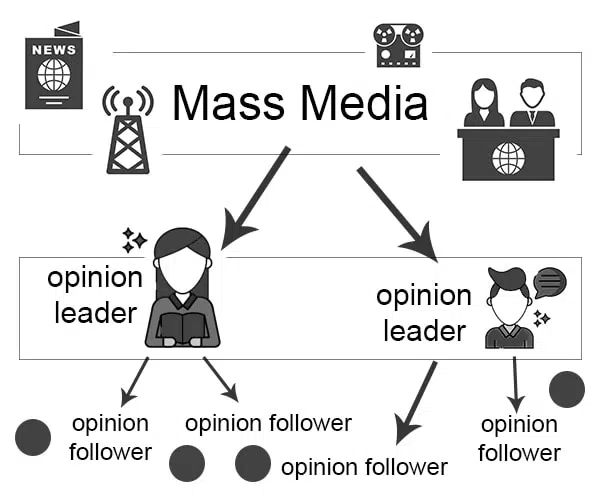By Lilli Pert

Understanding the Two-Step Flow Theory:
How Influence Really Works
In todays ever changing society and digitally-connected world, it is also seems almost natural to assume that our screens have a direct channel of communication into our minds, instantly influencing our beliefs. But if we take a moment to reflect on communication studies from earlier decades, we’ll see that the reality of influence is far more intricate. Before the rise of social media and viral content, researchers discovered something fascinating: mass influence isn’t as simple as it appears. Instead of a direct passage from sender to receiver, there’s often a more complex two-step process at play. This is where the Two-Step Flow Theory comes in, transforming our understanding of persuasion, how opinions form, and how information spreads.
The Birth of the Theory
The Two-Step Flow Theory took shape in the 1940s thanks to sociologists Paul Lazarsfeld, Bernard Berelson, and Hazel Gaudet, who were studying voter behavior during the 1940 U.S. presidential election. Their research, detailed in the book The People’s Choice (1944), challenged the dominant “hypodermic needle” or “magic bullet” theory of the time, which suggested that media directly implanted ideas into audiences’ minds.
What Lazarsfeld and his team found was quite surprising: people were not just passively absorbing media. Instead, they were discussing topics with one another and sharing their thoughts after conferring with those they trusted. This led to a critical insight: mass media leaves its mark in more subtle ways, particularly through “opinion leaders” — those influential individuals who help shape opinions in their communities.
The Two Steps of Communication
The break down of those steps:
Step One – Media to Opinion Leaders
In this first step, media outlets send messages out to opinion leaders, who then interpret and relay that information. Think of it like a game of telephone, where the initial message gets filtered through someone with the ability to influence the thoughts and beliefs of others. Opinion leaders—such as journalists, community figures, social media influencers, or anyone who keeps up with trends and news—are typically the first to consume media messages.
Step Two – Opinion Leaders to the Wider Public
In this second stage, opinion leaders take the information they’ve received and share it with their networks, whether through casual conversations, personal recommendations, or social media posts. Because these leaders have a personal connection and established trust with their peers, their opinions often carry more weight than generic messages from far-off media sources.
This idea highlights the importance of face-to-face communication in shaping our perceptions of what we see in the media.
Why It Still Matters Today
Even though the Two-Step Flow Theory was proposed well before the internet became a fixture in our lives, it remains incredibly relevant today. Platforms like Instagram, YouTube, and TikTok have only amplified this concept, as influencers and everyday users share their views, shaping public opinion in impactful ways.
This can be exemplified when a new product hits the market, many people are more likely to purchase it based on a recommendation from a trusted influencer or a friend rather than a company’s advertisement. These modern opinion leaders filter information and guide the opinions of others, echoing the roles described in Lazarsfeld’s study.
Beyond Two Steps
Today’s communication landscape is even more complicated. Some scholars have coined the term “multi-step flow” to acknowledge that influence often spreads through networks rather than merely a linear two-step process. Nevertheless, the core of the theory—that social relationships mediate media influence—continues to inform research in fields like marketing, politics, and digital communication.
In conclusion
The Two-Step Flow Theory reminds us that media influence is inherently social. We don’t form opinions based solely on what we read or see; we also rely on conversations with those we trust. In an era flooded with information, recognising these channels of influence helps us understand why our discussions—not just the messages themselves—truly shape our world.

